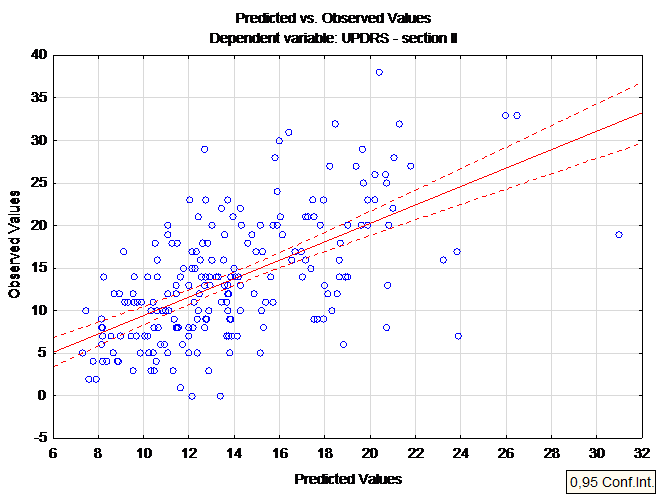Session Information
Date: Sunday, October 7, 2018
Session Title: Quality Of Life/Caregiver Burden in Movement Disorders
Session Time: 1:45pm-3:15pm
Location: Hall 3FG
Objective: The purpose of this study was to identify among several motor, cognitive and mental measures, which of them has the higher power to predict the QoL decrease in people with PD.
Background: Improving quality of life (QoL) is a key challenge in care of people living with Parkinson’s disease (PD). Then, to identify the best predictor for the decrease in QoL is a crucial step to develop more efficient approaches to avoid it. Among several measures which have been using to evaluate people with PD, we have no consensus about which one has higher power to predict the QoL decline.
Methods: Participated this study 236 people with idiopathic PD with mean age of 68.20+8.2, in I-V stages of disease evolution according to Hoehn and Yahr (H&Y) classification (6.10+4.5 year of disease evolution). The evaluations were fulfilled in two individual sessions, during the ON period of medication, using Unified Parkinsons´ disease Rating Scale (UPDRS) to assess general aspects of disease, the Mini-Balance Evaluation Systems Test (MiniBest), Falls Self-Efficacy Scale (FES) and number of falls in the last month to assess balance, the fear of falling, and the fall risk respectively, Montreal Cognitive Assessment (MoCA) to assess cognition, Geriatric Depression Scale (GDS) to assess depression, Timed Up and Go test (TUG) to assess the functional mobility, Six-minute Walk Test (6MWT) and 5XT to assess physical capacity, the Nine Hole Peg Test (9HPT) and manual strength (MS) measure by a dynamometer to assess strength and manual function, Freezing of Gait Questionnaire (FOG- Q) to assess the presence of freezing, and Parkinson’s Disease Quality of Life Questionnaire (PDQ-39) to assess the QoL.
Results: The statistical analysis showed a significant correlation between scores obtained in UPDRS, GDS, FOG, FES, MiniBest and TUG with PDQ-39 scores (p<.05). However, the multiple regression model showed that only UPDRS-section II was able to predict the PDQ-39 scores (R=.56; R²= .32 Adjusted R²= .31; F(1,172)=80.984; p<.000001). The analysis of predict and observed values confirmed the power of model (Figure 1).
Conclusions: The level of independence in DLA assessed by section II of the UPDRS is the best predictor for the decrease in QoL in people with PD. This suggest that the key point for treatment of people with PD is to keep the independence in DLA in order to avoid the decrease in QoL.
References: MOREIRA, R. C. et al. Quality of life in Parkinson’s disease patients: progression markers of mild to moderate stages. Arq. Neuro-Psiquiatr. São Paulo, vol 75, n 08, august 2017.
To cite this abstract in AMA style:
C. Dionizio, E. Okamoto, C. Miranda, M. d'Alencar, M.E. Piemonte. The independence in daily living activities is the best predictor for quality of life in people with Parkinson’s disease [abstract]. Mov Disord. 2018; 33 (suppl 2). https://www.mdsabstracts.org/abstract/the-independence-in-daily-living-activities-is-the-best-predictor-for-quality-of-life-in-people-with-parkinsons-disease/. Accessed December 23, 2025.« Back to 2018 International Congress
MDS Abstracts - https://www.mdsabstracts.org/abstract/the-independence-in-daily-living-activities-is-the-best-predictor-for-quality-of-life-in-people-with-parkinsons-disease/

